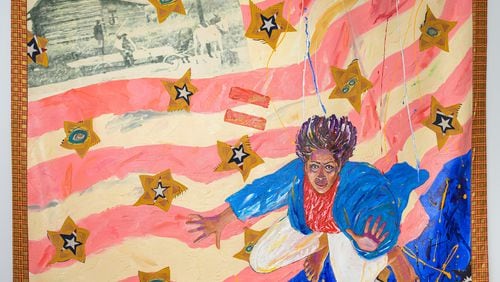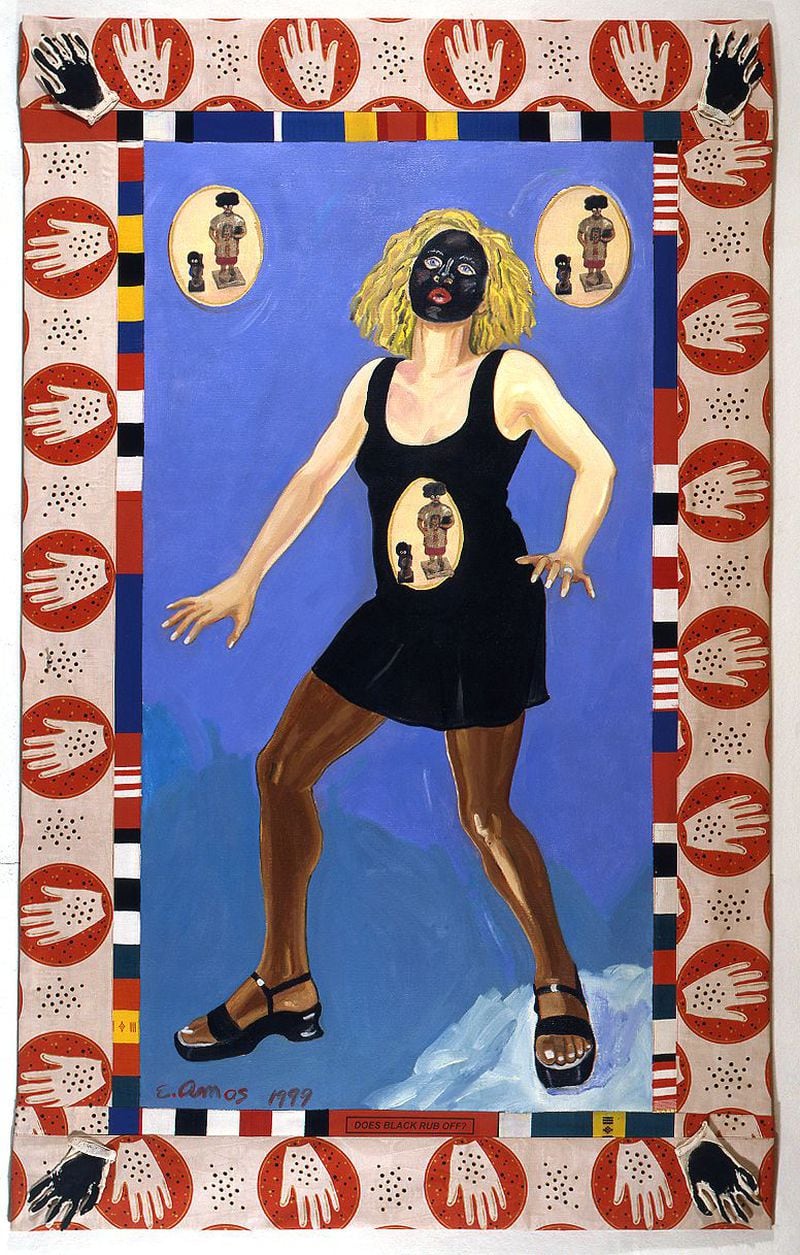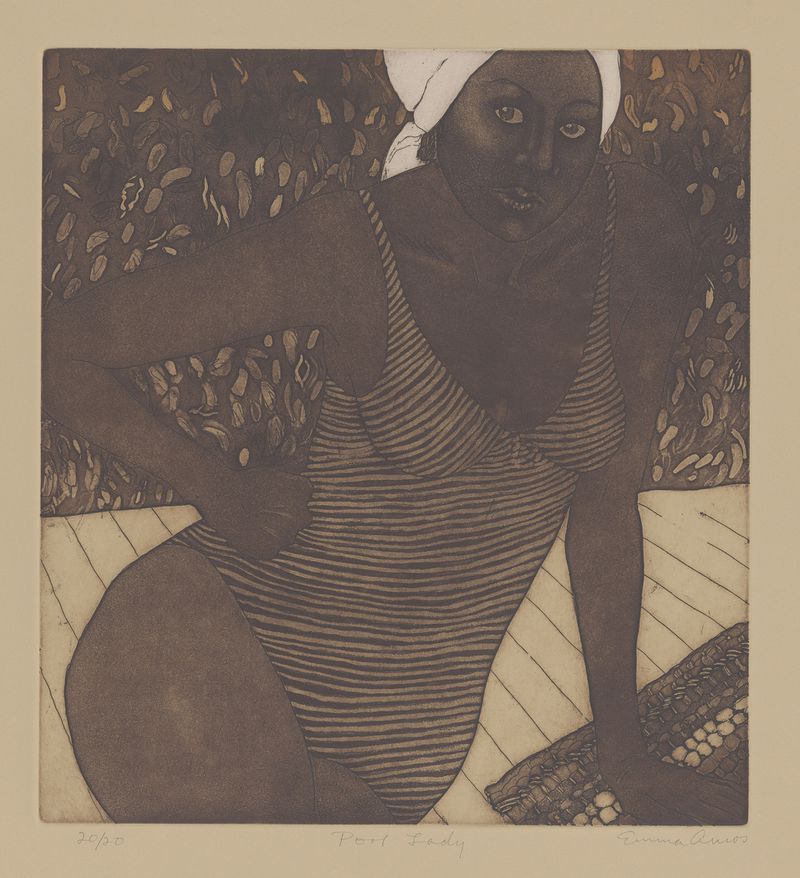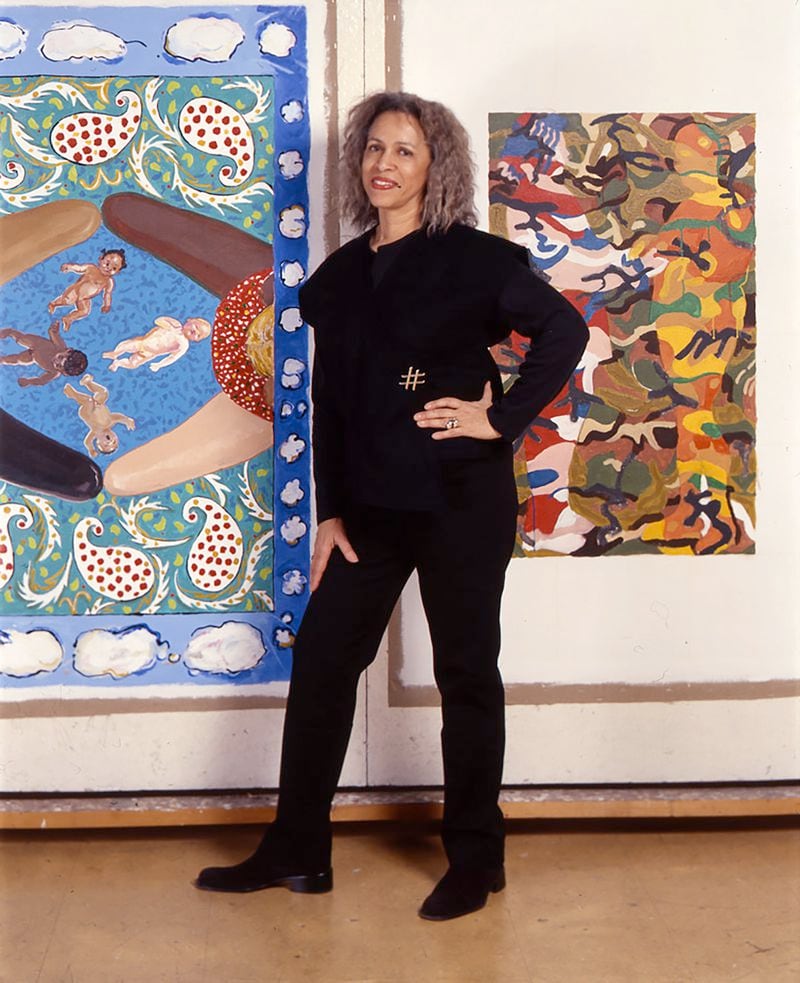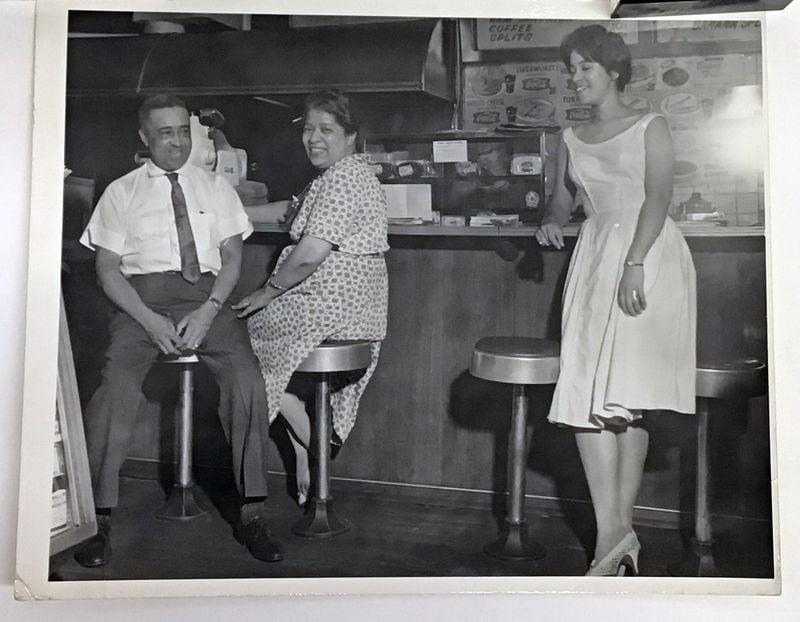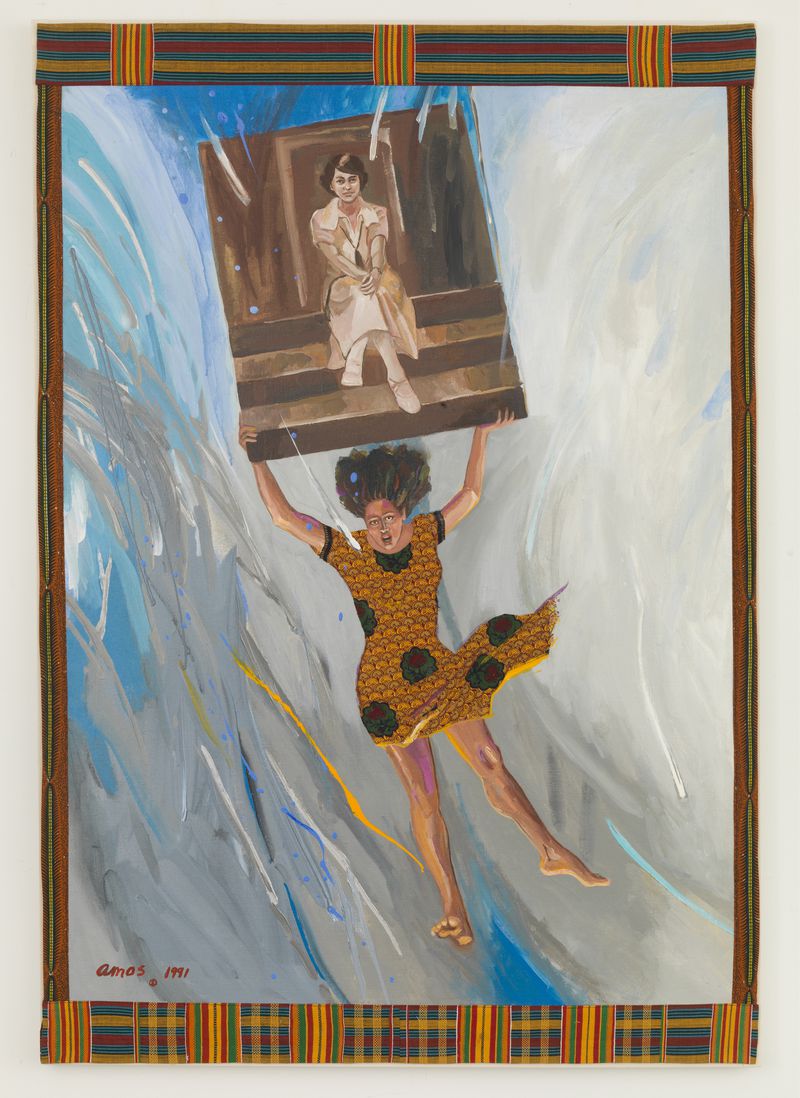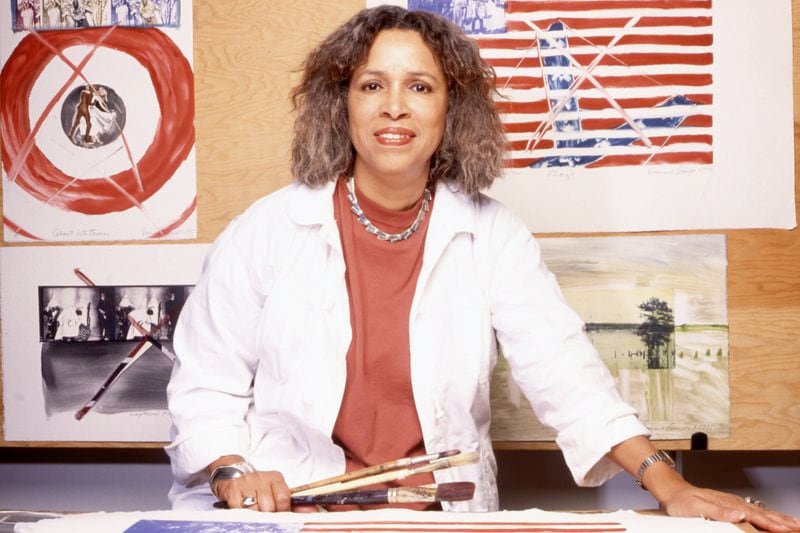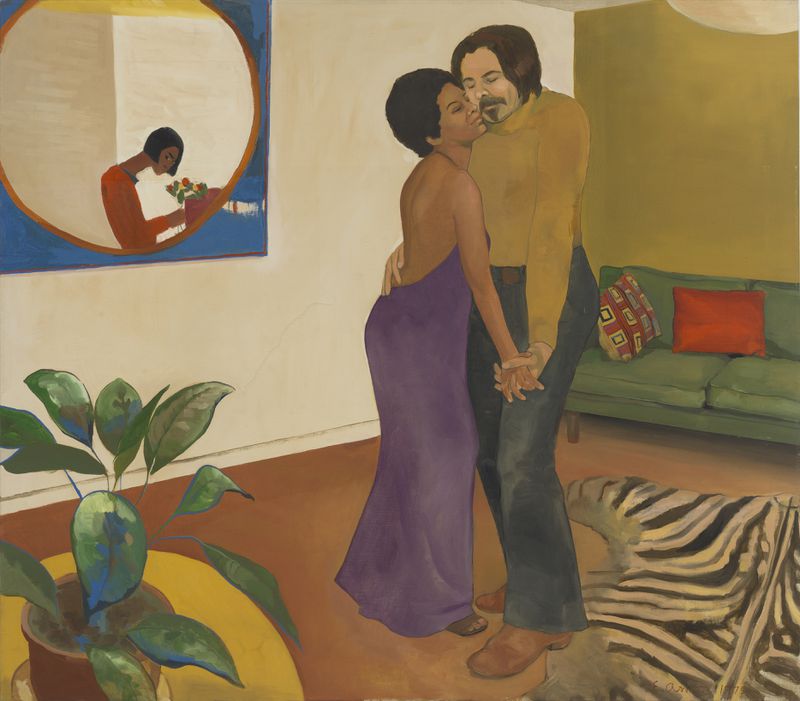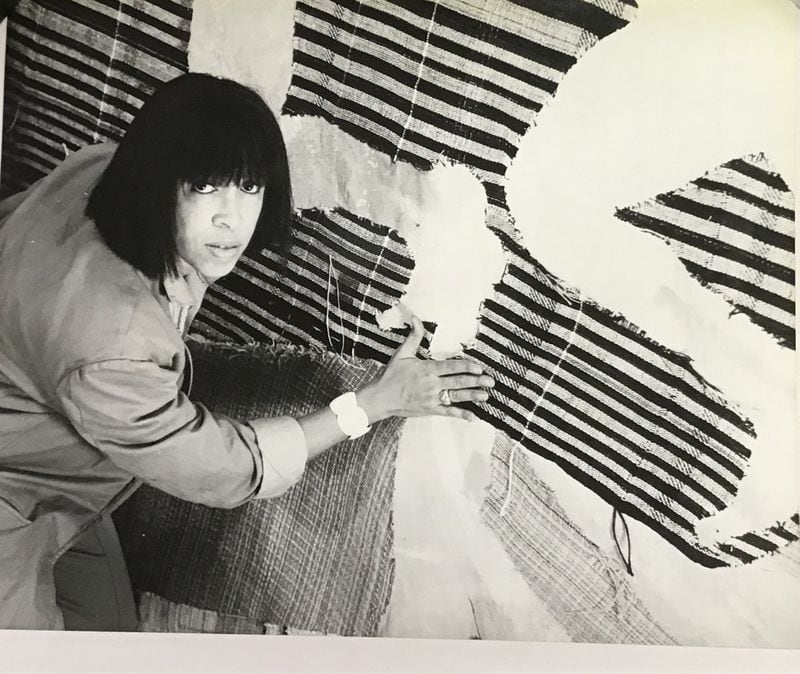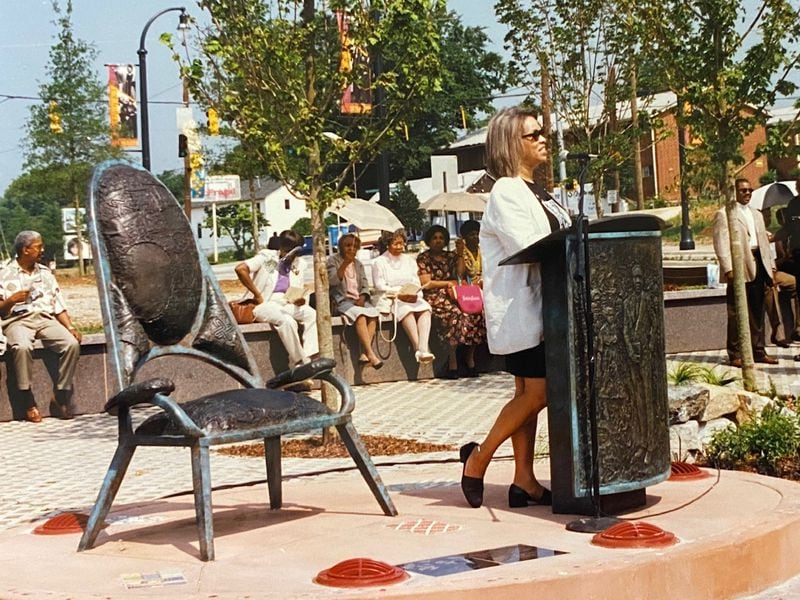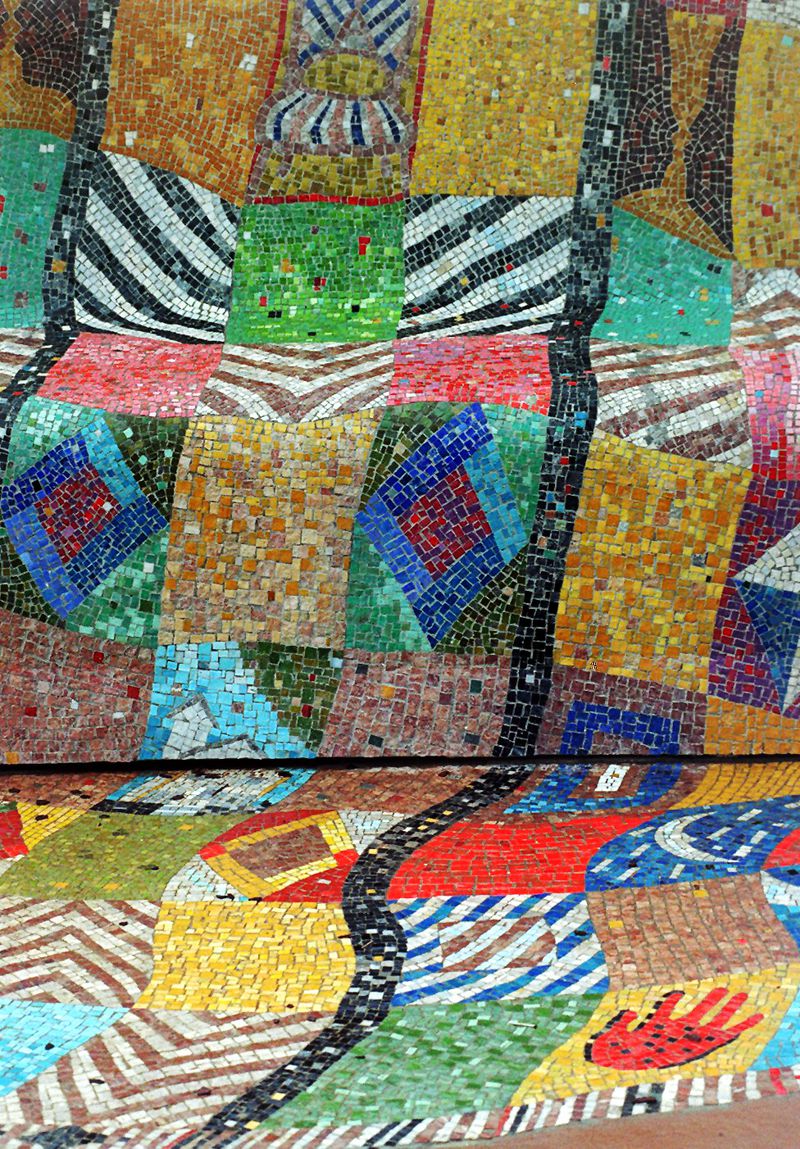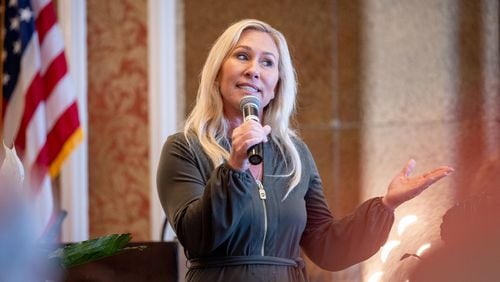After celebrating her 80th birthday at her Manhattan studio about four years ago, artist Emma Amos recalled something important about her future.
The corrosive effects of Alzheimer’s disease hadn’t yet erased the thought, and it was pleasing. She’d spent more than six decades as a working artist and she was finally going to have one of the things she’d truly wanted; a retrospective of her life’s work, a journey that began in the 1940s in the shadow of the Atlanta University Center. The retrospective, slated for early 2021 at the Georgia Museum of Art at the University of Georgia, would be a sort of homecoming.
Feminism and exclusion, race and racism, in the art world and beyond were themes she’d brought to life again and again in vibrant acrylics, oil paint, watercolor, ink, African textiles and black-and-white photography. Her demand that viewers consider those themes was sometimes blunt.
Credit: Emma Amos
Credit: Emma Amos
She might inset a photo of a sharecropper’s cabin or an image of people of varying hues, into the center of the Confederate battle flag to question the Civil War’s origins and legacy, or the construct of race itself. A 5-foot apron painted and appliqued with images of herself, Pablo Picasso and African tribal masks might ask who was the more significant artist, Picasso or the unnamed Africans whose works inspired some of Picasso’s masterpieces? Or her pieces asked viewers to reconsider their assumptions, such as her etchings of Black women lounging poolside. Were the images acknowledging the difficult fact most Black people can’t swim? Or were they simply celebrating curvaceous Black bodies?
Credit: Georgia Museum of Art
Credit: Georgia Museum of Art
Some or none of that could be true. What is certain is that Amos considered walking into her studio, as she is often quoted as saying, as a necessary “political act.”
In her eighth decade and long retired from her job as chair of the Rutgers University School of Art, Amos saw some of the world’s great galleries buying her work at last. She was not unknown, yet, popular recognition on a large scale eluded her.
“She told me how proud she was to have her work come home to a Georgia museum and invited me to meet her there,” her older brother, Larry Amos, said recently.
But the decline in her health was swift. Her studio shuttered for good before the pandemic took hold last spring and she was moved to an assisted living facility in New Hampshire.
“Emma Amos: Color Odyssey” is scheduled to open on Jan. 30, at the Georgia Museum in Athens, with more than 60 works by Amos. The artist will not be there. She died in May from complications due to Alzheimer’s.
Given the continuing danger of the coronavirus, it’s unlikely her 85-year-old brother, a retired attorney in Louisville, Kentucky, will see the exhibition in person before it closes on April 25. Yet, the show, conceived and curated by Shawnya Harris, curator of African American and African Diasporic Art at the Georgia Museum, will welcome the public despite the pandemic.
It is, many say, a long overdue honor for an artist who challenged a mainstream art world that historically excluded artists such as herself or rarely viewed them as peers without need of qualifiers such as “Black” or “female.” Her work has been included in larger group exhibits over the years and in smaller solo surveys, but the Georgia Museum show marks a significant moment in the growing appreciation of her art and importance as a creator.
“It wasn’t that long ago that some of her major works were still in her studio and not yet in a major museum collection,” said Emily Hanna, senior curator for the Arts of Africa and the Americas at the Birmingham Museum of Art. “Museums were slow to see her importance.”
The Birmingham museum holds one of Amos’s best-known pieces, “Measuring, Measuring,” which interrogates European standards of beauty and who gets to define who and what is beautiful. In many ways Amos had to do something similar: claim her own space and set her own standards for success.
“For Black women artists of Emma’s time, you have to look at what careers are open to you as a woman, then you delete,” said Lisa Farrington, Associate Dean of Fine Arts at Howard University, a longtime close friend of Amos’ and scholar of her work. “Then you look at what careers are open to you as a Black person and you delete. Then you look at what careers are open to you as a Black person and a woman and you delete. So where does that leave a Black woman who wants to be an artist? Emma said, ‘I’m doing it anyway.’ Then to succeed in a field most people don’t think is important; that takes lot of courage.”
Credit: Ryan Lee Gallery
Credit: Ryan Lee Gallery
‘Enormous positive influence’
In the 1991 self-portrait “Will You Forget Me?,” Amos depicts herself plunging downward. It’s hard to tell whether the blue and gray streaks behind her represent clouds and sky, the torrents of a waterfall or the passage of time. Her dress, of gold African wax-print fabric, and her dark brown hair are caught in the rush. Her hands, held above her head, clasp a sepia portrait of a young Black woman posing primly. The woman is dressed in the fashion of the 1920s. She is India Amos, the artist’s mother, who, along with Amos’ father, Miles Amos, set their daughter on an artistic path in the 1940s.
The slights and indignities of segregation were then the order of the day. Nevertheless, Black families created culturally rich worlds and the Amos’ were no different. Amos’ grandfather, Moses, was the first licensed Black pharmacist in Georgia and owned Gate City Drugstore on Auburn Avenue. Miles Amos also became a pharmacist and opened Amos Drug Store on Ashby and Hunter streets (now Joseph E. Lowery Boulevard and Martin Luther King, Jr. Drive).
Until it closed in 1969, the Ashby Street drugstore was a community hub not just for the neighborhood, but for Black intellectuals, professors and literary stars. W.E.B Du Bois was a frequent visitor to the store and the nearby Amos home in the 1930s and early 1940s while he was a professor at Atlanta University, now Clark Atlanta University. Morehouse College President Benjamin Mays would stop by as well. Booker T. Washington was a hunting buddy of Amos’ grandfather. Occasionally, Zora Neale Hurston visited, as would Martin Luther King, Jr.
“The impact of having leading Black educators, civil rights activists and sociologists in our home was an enormous positive influence on Emma and me,” Larry Amos said.
So was the proximity to Spelman, Morehouse, Clark and Morris Brown colleges as well as Atlanta University. The Amos siblings attended Spelman’s nursery school. When Emma Amos started drawing at about five years old, first by tracing images from magazines her father brought home from the drugstore, her parents didn’t discourage her. India Amos had attended Fisk College when artist Aaron Douglas started painting his now famous murals about Black life on the walls of the campus library. The sepia portrait that would later inspire “Will You Forget Me,” was taken just a few years before he began.
By the time Emma Amos was 11 years old, her parents asked famed muralist Hale Woodruff, then on faculty at Atlanta University, to tutor her. He balked, saying she was too young. But their paths would cross years later.
Determined her daughter get formal training, Amos’s mother turned to Ruth Hall Hodges, chair of the art department at Morris Brown College. Hodges did not balk. Not yet a teenager, Amos sat in on undergraduate art classes.
“Even in the 1940s, very few parents were envisioning their child’s life as an artist,” said Akua McDaniel, former chair of Spelman’s art department and the first director of the Spelman College Museum of Fine Art.
But given the family’s association with creatives, McDaniel said she believes India Amos “felt comfortable urging her daughter to pursue life as an artist.”
Credit: Emma Amos Family
Credit: Emma Amos Family
While still a student at Booker T. Washington High School, Amos entered Atlanta University’s seminal art competition, “Exhibition of Paintings, Prints and Sculpture by Negro Artists of America,” founded by Woodruff in 1942. It was held annually until 1970. Though Amos would not place until she competed again years later, the high school foray was a significant step. Some of the 20th century’s most important Black artists and photographers found the competition one of the few reliable venues to get their work shown and purchased: Roy DeCarava, Elizabeth Catlett, Jacob Lawrence, Lois Mailou Jones, Norman Lewis and Charles White among them. Aaron Douglas who painted the Fisk College murals was one of the first judges of the annual competition.
In their segregated world, Amos’ parents saw possibilities for their daughter the mainstream art world had yet to envision. As she grew, Emma Amos fought to clear her own path.
Credit: Emma Amos
Credit: Emma Amos
‘Blood money’
Prior to legal integration, Georgia had a policy of reimbursing Black college students for part of their tuition if they chose to attend an integrated out-of-state graduate school. Larry Amos said his father called the policy, “blood money,” and refused to apply for the program.
Though her views on segregation and race matured while she earned art degrees at Antioch College in Yellow Springs, Ohio, and the Central School of Art and Design in London, Emma Amos’s beliefs “were born in the Jim Crow South,” her brother said.
“I see this anti-segregationist tension and Emma’s reaction thereto in much of Emma’s work,” Larry Amos said.
Take for instance her 1994 piece, “Confederates.” She has taken a group photo of three people, a white woman, a Black man and a light-skinned Black woman. The latter is Amos. The faces of the other two figures are intentionally blurred. She’s centered the picture on a painting of the Confederate battle flag. Amos was eight years old when the Ku Klux Klan resumed burning crosses atop Stone Mountain. Deep fear of miscegenation among some Southern whites fueled the hate group. The “Confederates” piece calls out that fear. Amos was more direct in the 1995 painting, “About Whiteness.” It depicts a lynching scene from the 1915 movie “The Birth of a Nation,” a film credited with the Klan’s 20th-century resurgence. Below that image, in the center of a red bull’s eye, a nude Black man seems to sweep a blonde white woman in a flowing white gown off her feet. The pair have been crossed out with a large red “X.”
Credit: Ryan Lee Gallery
Credit: Ryan Lee Gallery
Those themes weren’t as prominent in her early career. Her first small solo show of drawings and etchings in Atlanta at the Alexander Gallery in 1960 (made possible in part by Buckhead art patron and founder of the then Atlanta Art Festival, Caroline Becknell) embraced abstract expressionism. That same year she earned an honorable mention in the Atlanta University art annual competition for an etching titled, “Reeds,” said Tina Dunkley, former director of the Clark Atlanta University Art Museum.
Amos soon enrolled in graduate school at New York University. By then, Woodruff was teaching there. Through him, Amos was invited to join the Spiral collective. They’d meet to talk about what it meant to be Black artists in a time of civil rights struggle and whether their work should even be bound by racial categories. There was also talk of how difficult it was for them as Black artists to get gallery representation and sell their works for their true worth.
Though there were more established Black women artists who’d tried to join, Amos was the only woman invited to be part of the group of Black male artists that included Woodruff, Romare Bearden, Charles Alston, Norman Lewis and others.
“She felt they chose her because she was the ‘safe choice,’” said Harris, curator of the Georgia Museum retrospective.
Amos taught at a private school for a while then began working for the textile designer Dorothy Liebes, who encouraged her to use the weaving and fiber skills she’d learned in college. Designing fabric was art, not craft, and Liebes was heralded for her mastery. Firmly planted in New York, Amos married, had two children and began painting scenes of domestic life, but eventually the lessons from Liebes and Spiral fused.
Credit: Emma Amos
Credit: Emma Amos
“I think the civil rights movement made me more critical about what I was doing,” Amos told the author and cultural critic bell hooks, in the 1995 book “Art on My Mind.” “I could not in good conscience paint just lovely pictures with brushy strokes without having some of the pain and angst of the thing that I wanted to say about women, Black women in particular.”
‘Falling Figures’
Margaret Spriggs remembers walking into Hammonds House Museum in the West End sometime around 1993 and being wowed. Above her hung a bright canvas depicting a woman falling through space. Bordered by African wax-print cloth, the piece hung loosely, almost floating.
“I related to it as a female because sometimes it feels like you’re falling into something and you don’t know what will be at the bottom when you get there,” Spriggs said.
The piece was from Amos’ “Falling Figures” series, which included “Will You Forget Me?” Spriggs’ husband, Ed Spriggs, was the founding director of Hammonds House and former director of the Studio Museum of Harlem. He was proud Hammond’s House was a stop on the tour “Emma Amos: Paintings and Prints, 1982-1992.” The falling figures, often women but sometimes men, tumbled through space, though not necessarily to a doomed fate. The ground was never visible, reflecting the deep uncertainty and sense of loss many Americans felt during the Reagan era, the artist once said.
“The falling women left a lot of people perplexed and wondering why all the women were falling, but Emma had her iconography hooked up,” Ed Spriggs said. “Emma was interested in freeing the woman’s image and giving her a place in the world. She was very clear about that.”
Even so, Amos didn’t embrace integrated feminist movements until well into the 1980s. She joined the Heresies Collective which advocated for better representation for women in the art world. Then, she donned a hairy, black, gorilla mask and joined the Guerrilla Girls, an arts activist group which publicly called out museums on billboards, in media and performance pieces, for their lack of female representation in exhibitions and staffing. Part uniform, part disguise, the masks, which each member wore, were like armor.
But at Hammond’s House that night, Amos smiled and greeted friends from the old neighborhood.
“There was a feeling she had been overlooked locally,” Ed Spriggs said. “People knew about the family because of the drug store. By the time she got to Hammonds House, her reputation on the East Coast was more established. Like Faith Ringgold, she was known as a storyteller. Hammonds House was like a homecoming for her.”
Credit: Ryan Lee Gallery
Credit: Ryan Lee Gallery
As part of the 1996 Olympics’ public art program, Amos returned to Atlanta to install a major tribute to civil rights leader, the Rev. Ralph David Abernathy Sr., in Mechanicsville. Titled “We Will Not Forget,” the installation, in Abernathy Plaza, includes symbols of his life: a mosaic couch represents his family life; a bronze pulpit represents his profession as a minister and a crumbling bronze wall symbolizes the barriers of racial injustice he and Martin Luther King Jr. broke down together. The installation remains.
Credit: Susan Ross
Credit: Susan Ross
‘I did’
Once it leaves Athens, the retrospective will travel to the Philadelphia Museum of Art and the Munson-Williams-Proctor Arts Institute in Utica, New York. Harris, curator of the Georgia Museum show, remembers visiting Amos years ago in her studio. Many of the artist’s early works languished, propped up against walls.
“I was like, ‘Wow, who did that?,” Harris said. “And she was like, ‘I did. It’s my early work. Nobody would be interested in that now. Nobody would buy it.’”
Yet, the power of Amos’s vision holds.
Last year fashion designer Duro Olowu, whose clothes Michelle Obama frequently wore, told British Vogue that Amos’s work inspired one of his recent collections. YouTube bloggers have devoted episodes to the artist. And in the last four years at least 18 major museums have acquired her work including the Whitney Museum of American Art, the Studio Museum in Harlem, the Art Institute of Chicago, the Smithsonian, the Metropolitan Museum of Art, the Museum of Modern Art, the Crystal Bridges Museum of American Art and the British Museum. In Georgia, her pieces are part of the permanent collection at the Spelman College Museum of Fine Art, the Clark Atlanta University Museum, the Georgia Museum and the Morris Museum of Art in Augusta.
Within the art world Amos critiqued so fiercely, there are signs of systemic movement. Major institutions such as the National Gallery of Art and the High Museum, hired their first, full-time, Black female curators within the last year. The Guggenheim appointed its first, Black deputy director and chief curator.
Some might attribute the changes to the racial reckoning that seized the country after the killing of George Floyd. It’s hard not to imagine how might Amos render this moment were she alive. Of course, there would be masterful splashes of color. But would the figures plunge or would they rise?
Credit: FRANK NIEMEIR
Credit: FRANK NIEMEIR
Event Preview
“Emma Amos: Color Odyssey”
Jan. 30-April 25
10 a.m.-9 p.m. Thursdays; 10 a.m.-5 p.m. Fridays-Saturdays; 1-5 p.m. Sundays. Free, though timed tickets must be reserved via the museum’s website. Georgia Museum of Art, 90 Carlton St., Athens. 706-542-4662, georgiamuseum.org.
About the Author
